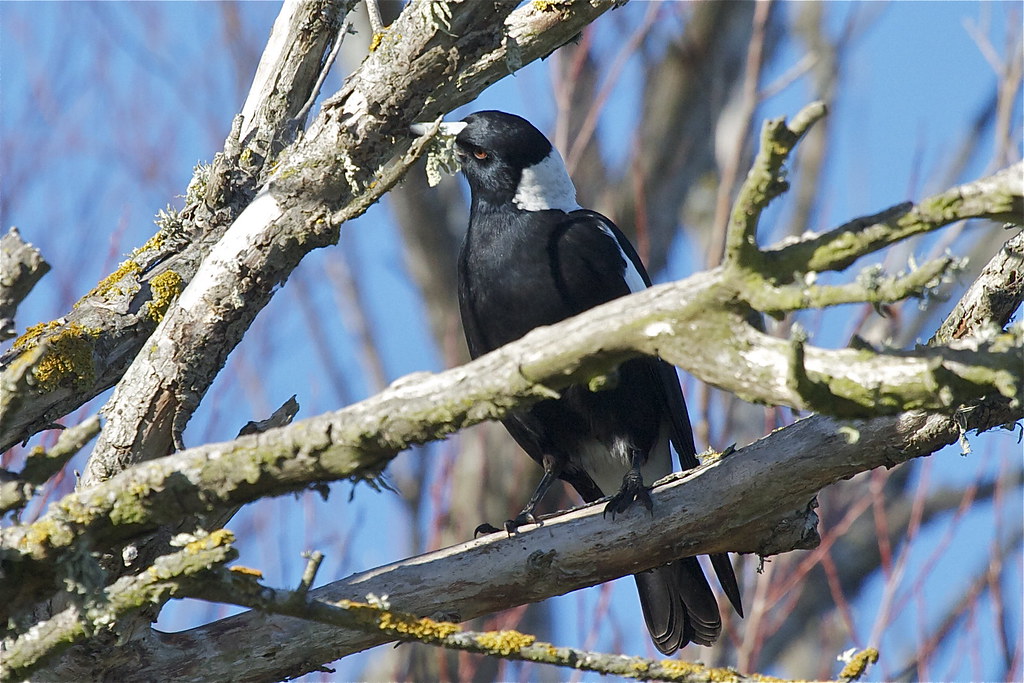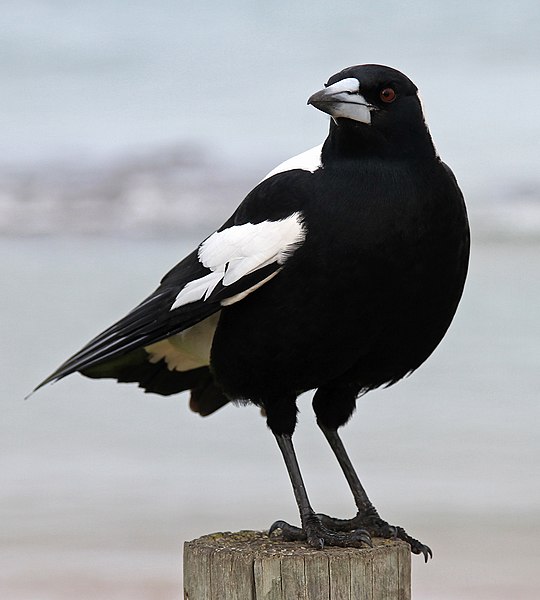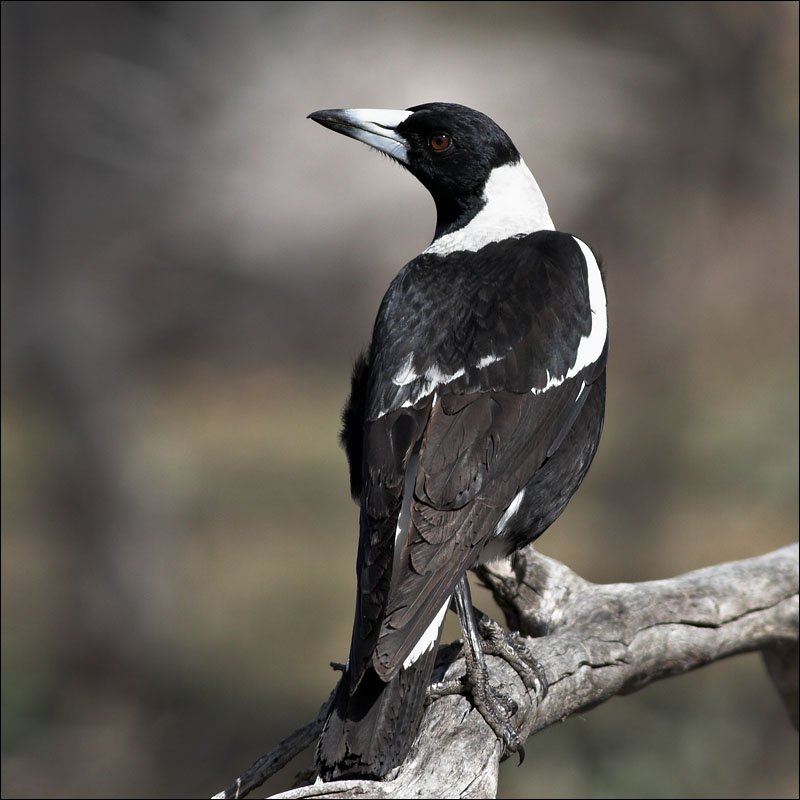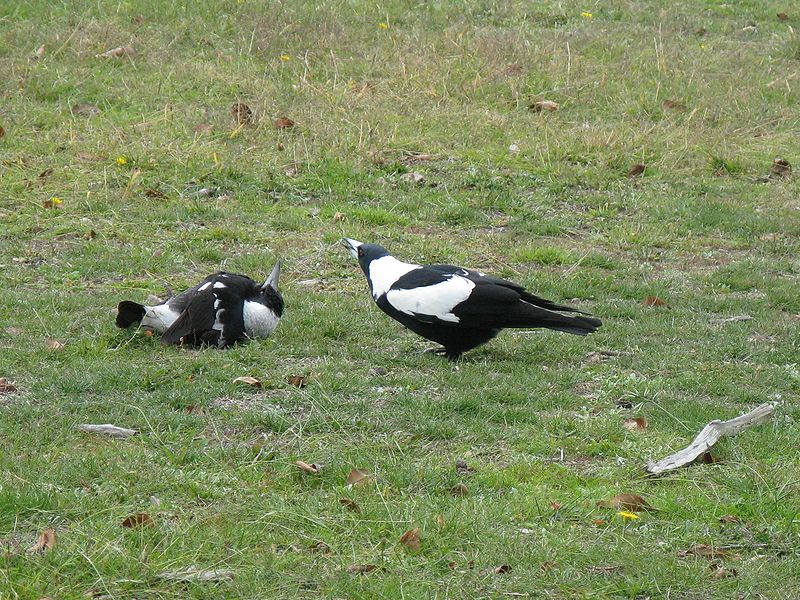.

Australian Magpie (Gymnorhina tibicen), Canterbury, New Zealand: photo by Steve Attwood, 4 June 2012
When Tom and Elizabeth took the farm
The bracken made their bed
and Quardle oodle ardle wardle doodle
The magpies said
Tom's hand was strong to the plough
and Elizabeth's lips were red
and Quardle oodle ardle wardle doodle
The magpies said
and Elizabeth's lips were red
and Quardle oodle ardle wardle doodle
The magpies said
Year in year out they worked
while the pines grew overhead
and Quardle oodle ardle wardle doodle
The magpies said
while the pines grew overhead
and Quardle oodle ardle wardle doodle
The magpies said
But all the beautiful crops soon went
to the mortgage man instead
and Quardle oodle ardle wardle doodle
The magpies said
to the mortgage man instead
and Quardle oodle ardle wardle doodle
The magpies said
Elizabeth is dead now (it's long ago)
Old Tom's gone light in the head
and Quardle oodle ardle wardle doodle
The magpies said
Old Tom's gone light in the head
and Quardle oodle ardle wardle doodle
The magpies said
The farm's still there. Mortgage corporations
couldn't give it away
and Quardle oodle ardle wardle doodle
The magpies say.
couldn't give it away
and Quardle oodle ardle wardle doodle
The magpies say.
Denis Glover (1912-1980): The Magpies, from Recent Poems, 1941

Australian Magpie (Cracticus tibicen), Hawkes Bay, New Zealand: photo by Mike Grainger, 6 July 2012

Australian magpie, Cracticus tibicen tyrannica, alternatively known as Gymnorhina tibicen tyrannica. Queenscliff, Victoria, Australia; photo by John O'Neill, 5 July 2010; edited by Noodle snacks, 7 July 2010

Australian magpie, Cracticus tibicen tyrannica, alternatively known as Gymnorhina tibicen tyrannica. Queenscliff, Victoria, Australia; photo by John O'Neill, 5 July 2010; edited by Noodle snacks, 7 July 2010
Australian Magpie (Cracticus tibicen hypoleuca), male, Queen's Domain, Hobart, Tasmania, Australia: photo by Noodle snacks, 29 June 2010

Australian Magpie (Gymnorhina tibicen), Samsonvale Cemetery, SE Queensland, Australia: photo by Aviceda, May 2005

An immature Brown Goshawk (Accipiter fasciatus) in flight chased by an Australian Magpie (Gymnorhina tibicen): photo by JJ Harrison (Noodle snacks), 28 August 2009

Australian Magpie, Gymnorhina tibicen, venturing inside at walking gait, Longwood, Victoria, Australia: photo by Erin Silversmith, 15 January 2006

Australian Magpie, Gymnorhina tibicen, female, race dorsalis, in a Fremantle surburb, presumably collecting nesting material from a paperbark (but you-never-know with this mob?!). Distinguished by the scalloped back: photo by Cygnis insignis, 26August 2007

Two Australian Magpies (Cracticus tibicen) in Victoria Park, Sydney, New South Wales, Australia. On the left is a juvenile (note the dark eyes) calling for food. The mother on the right has just obtained a piece of apple and is about to pass it over: photo by Toby Hudson, 21 September 2011

Australian Magpie (Cracticus tibicen), Canberra area: photo by Julian Robinson, 9 September 2007







15 comments:
Tom,
Just look at those lovely, quirky, quarky birds -- and while we're at it hear exactly the "Quardle oodle ardle wardle doodle" songs they sing. . .
6.26
silver edge of sun rising over shadowed
plane of ridge, bird calling from field
in foreground, sound of wave in channel
build up, made its approach
present with which it
was used to move, “abstract”
impasse, hear exactly
grey white clouds reflected in channel,
pelican flapping across toward horizon
For a bit of information about the poet:
Note on Denis Glover in Oxford Companion to New Zealand Literature.
The Australian Magpie (Cracticus tibicen) is not a 'true" Magpie at all, in fact a closer relative to the butcherbird, and it is a late introduction from its native land to New Zealand, where its reputation became mixed yet its fame great, its call inspiring this, perhaps the country's best-loved poem.
The limited musical receptors of the cumbersome and ponderous homo sapiens stand back in silent wonderment before the complex song of Cracticus tibicen.
In Australia Cracticus tibicen expects to be fed by humans as part of its territorial domain and in return is known to attack humans indiscriminately and aggressively, during nesting time swooping with ill intent upon anyone in the close vicinity who possesses two legs, even though those legs might be attached (hip bone connected to the thigh bone and so on) to the hand that might just now have fed. Malgré the Ray-Bans so they say.
Aggressive, unapologetic.
"...the Australian Magpie has a wide variety of calls, many of which are complex. Pitch may vary over up to four octaves, and the bird can mimic over 35 species of native and introduced bird species, as well as dogs and horses. Magpies have even been noted to mimic human speech when living in close proximity to humans..."
"When alone, a magpie may make a quiet musical warbling; these complex melodious warbles or subsongs are pitched at 2–4 KHz and do not carry for long distances. These songs have been recorded up to 70 minutes in duration and are more frequent after the end of the breeding season. Pairs of magpies often take up a loud musical calling known as carolling to advertise or defend their territory; one bird initiates the call with the second (and sometimes more) joining in. Often preceded by warbling, carolling is pitched between 6 and 8 kHz and has 4–5 elements with slurring indistinct noise in between. Birds will adopt a specific posture by tilting their heads back, expanding their chests, and moving their wings backwards. A group of magpies will sing a short repetitive version of carolling just before dawn (dawn song), and at twilight after sundown (dusk song), in winter and spring."
And this is just the Prologue to the Poem.
To those red lips, the strong hand, the years and the growing pines, the crops, the mortgage man, death and the light head the same reply.
Those are some birds.
The stubborn insistence of certain creatures on standing their ground and not having the space violated, that suggests a strength in the living.
I quite like the Glover poem, it has that long-view quality of a Border ballad, Twa Corbies-ish, while also understanding a thing or two about economics and history (human, that is, quite apart from Magpie).
Also the bit about Old Tom, too late to argue the truth of that.
These birds have strong beaks for breaking things open and for drilling and ripping away. Are they poets? Are they black and white ravens?
Everything continues in Glover's poem song with only an echo of an exotic bird, "while the pines grew overhead" seems to observe the couple, their efforts. "The Magpies" puts us on the ground, hopping and looking at bugs, too, before flying away. The Australian Magpie seems rugged and gets down to business. Here, the magpies are all feathers, spread for gliding in and swooping under the Ponderosa pine branches, the warmed forest floor. Their black iridescence and painted white distracting, abstract.
The pines didn't care about human matters any more than do the Magpies, but the pines at least have better manners about it, not flaunting their lack of concern by hopping about and never stopping the Quardle oodle ardle wardle doodling.
Endless, relentless. In that respect the poet resemblance, I do get that.
This bold and prepossessing bird would seem a poet from a much earlier Age, though.
For musicality not to speak of ferocity and sheer pecking pestiness our shrinking violet poets of today could hardly stand up to it for long.
Furthermore it is neither Raven nor Crow but fills a category occupied by few familiar (to us, that is -- certainly they are familiar with one another, in that birds and bees way) relations.
(Though the butcher bird and dusky woodswallow might have due cause to resent being dismissed thus lightly.)
The bird was named for its similarity in colouration to the European Magpie; it was a common practice for early settlers Down Under to name plants and animals after European counterparts. However, the European Magpie is a member of the Corvidae, while its Australian counterpart is placed in the Artamidae family (although both are members of a broad corvid lineage).
The Australian Magpie was first described by English ornithologist John Latham in 1802 as Coracias tibicen, the type collected in the Port Jackson region. Its specific epithet derived from the Latin tibicen "flute-player" or "piper" in reference to the bird's melodious call.
Keeping in mind the poet is named to be not a singer but a maker of something. Different sort of business altogether that.
Australian Magpies were introduced into New Zealand in the 1860s and are proving to be a pest by displacing native birds. Whereas entire schools and squadrons of poets have been unable to dislodge native human speakers of prose.
Spring in Australia is magpie season, when a small minority of breeding magpies (almost always males) around the country become aggressive and swoop and attack those who approach their nests, especially bike riders and poets who have lost their way en route to the Conference.
beautiful intelligent bird!!
Well, there are usually lots of signs pointing the way to the Conference, conveniently located across from a Wells Fargo (bank).
O.K., so side by side the couple toils on their farm in Nature. Pines are there and the (other) introduced species of Empire, too. They go on side by side but the bird is commenting in song (nonsense language) and the poet is most interested in seeing the nest of this bird, how it is built and the nest of this couple that nobody wants, even for free. Magpie, pines, farming couple almost intersect but don't overlap in this poem. They are kept separate when we read it. Remembering this poem or thinking about it, they seem to merge more.
Intelligent enough to read the signs... but to operate the automatic teller?
Something here suggests the Conferees might just soon the Magpies didn't make it.
It's hard to say whether the Magpies' apparent indifference all along -- seeming to approve and bless when things go well for Elizabeth and Tom, then not seeming to mind a whit when things don't -- should be taken merely as a sign of philosophical equanimity, or as something less disinterested.
(Their song only seems like Nonsense to us, by the by, to each other it comes across as perfectly... well, perhaps "sensible" would be going a bit far. But still.)
And the longer one considers the matter, the more it begins to seem that the pines' inability to get up and hop about may prove fatal to their prospects of making it to the Conference on time in any case.
"Magpies are believed to be one of the most intelligent of all animals: the European Magpie is one of the few animal species known to be able to recognize itself in a mirror test.[2]. In the UK, the Magpie has long been associated with a habit of stealing or otherwise collecting shiny objects, however this urban myth has no evidence in wildlife studies..."
I remember now of a fairy story I was read as a child and the impression I got when it said that a "bird" (I do not remember now if it told which kind of bird it was) had stolen a very expensive ring entering through an open window to a room...etc.
It was little more than luck that I became enamored of watching the bohemians come in and out
of my life, almost as if on and off a stage. It wasn’t them that I got to know, really, but their habits and ways. It was a beautiful experience, just seeing another sort of attitude. It wasn’t my own, but then became my own.
Magpie at the famous writing conference, I decided to try my luck. There were new house decks, Saudi oil, mazes, and angry sons playing music to hide their bottomless disappointments, Michael Jackson aficionados, New York dolls, and society page vortexes. There were also the cute marrieds and secret meths. One heroin that I knew of—under the bridge. All the pressure of hob-knobbing with the best of them. That was not so surprising—we were at a college in the great Northwest, after all. But still, it was disturbing on a deeper level. The level of safety and having a safe life. It wasn’t. The safety swam away or else solidified blandly into a gelled, tense smile.
The magpies that frequent our garden stop over on the tip of our tallest trees—a pair of twinned Leyland cypresses –and keep a watch to see where the mourning doves have built their nests. Once they spot them, the ensuing scene can aptly be described as a rather noisy battle for breakfast at the “Milk and Honey” House.
http://www.youtube.com/watch?v=mi2EDDjDOgU&feature=autoplay&list=AL94UKMTqg-9BDVQOrorOMV2Qz04H1Piyu&playnext=1
Nina Simone: Ain't Got No... I've Got Life
Post a Comment